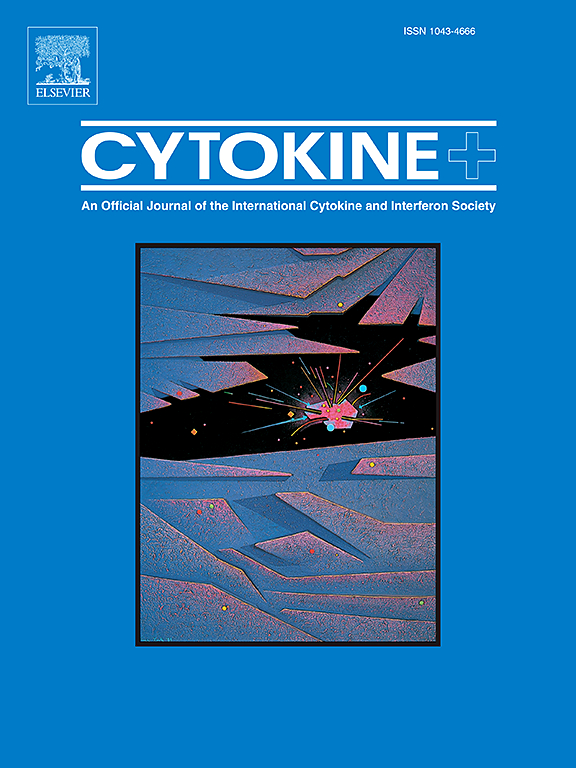A cross-sectional study investigating the underlying inflammatory mechanisms of post-stroke insomnia
IF 3.7
3区 医学
Q2 BIOCHEMISTRY & MOLECULAR BIOLOGY
引用次数: 0
Abstract
Background
It is widely postulated that inflammation contributes to the pathogenesis of both stroke and insomnia; and vice versa. However, the mechanism underlying post-stroke insomnia (PSI) remains ambiguous. Therefore, this study aims to elucidate the potential inflammatory mechanisms associated with PSI and evaluate its predictive value.
Methods
A cross-sectional study was conducted among patients with acute stroke who were enrolled in this investigation. Sleep quality was evaluated using the Pittsburgh Sleep Quality Index (PSQI), alongside the assessment of 12 cytokines and complement component 1q (C1q) levels. The anxiety (HAD-A) and depression (HAD-D) states of patients were assessed utilizing the Hospital Anxiety and Depression Scale. Statistical analyses were conducted to compare differences in each indicator among patients with various types of stroke and varying sleep quality.
Results
The prevalence of sleep disorders among patients with acute stroke is as high as 75.7 %. There were no significant differences observed in the PSQI scores and cytokines across different subtypes of strokes. However, significant differences were found in Interleukin (IL)-6, Interferon-α(IFN-α), and C1q levels, as well as in HAD-A and HAD-D scores among PSI patients. Binary logistic regression analysis revealed that C1q, IL-6, IL-10, IL-12, HAD-A, and HAD-D had a significant impact on sleep quality. The receiver operating characteristic (ROC) curve indicated that only IL-6 and HAD-A scores predicted PSI.
Conlusion
Insomnia is common after acute stroke, potentially due to inflammation. IL-6 levels and anxiety could serve as predictors for PSI development, thereby presenting potential targets for therapeutic intervention.

一项横断面研究调查中风后失眠的潜在炎症机制
背景:人们普遍认为炎症与中风和失眠的发病机制有关;反之亦然。然而,中风后失眠(PSI)的机制仍不明确。因此,本研究旨在阐明与PSI相关的潜在炎症机制,并评估其预测价值。方法对入选的急性脑卒中患者进行横断面研究。使用匹兹堡睡眠质量指数(PSQI)评估睡眠质量,同时评估12种细胞因子和补体成分1q (C1q)水平。采用医院焦虑抑郁量表对患者的焦虑(HAD-A)和抑郁(HAD-D)状态进行评估。通过统计分析比较不同类型中风患者和不同睡眠质量患者各指标的差异。结果急性脑卒中患者睡眠障碍患病率高达75.7%。不同脑卒中亚型患者的PSQI评分和细胞因子无显著差异。然而,在PSI患者中,白细胞介素(IL)-6、干扰素-α(IFN-α)和C1q水平以及HAD-A和HAD-D评分存在显著差异。二元logistic回归分析显示,C1q、IL-6、IL-10、IL-12、had - a、had - d对睡眠质量有显著影响。受试者工作特征(ROC)曲线显示,只有IL-6和HAD-A评分能预测PSI。结论急性脑卒中后常见失眠,可能与炎症有关。IL-6水平和焦虑可以作为PSI发展的预测因子,从而提供治疗干预的潜在目标。
本文章由计算机程序翻译,如有差异,请以英文原文为准。
求助全文
约1分钟内获得全文
求助全文
来源期刊

Cytokine
医学-免疫学
CiteScore
7.60
自引率
2.60%
发文量
262
审稿时长
48 days
期刊介绍:
The journal Cytokine has an open access mirror journal Cytokine: X, sharing the same aims and scope, editorial team, submission system and rigorous peer review.
* Devoted exclusively to the study of the molecular biology, genetics, biochemistry, immunology, genome-wide association studies, pathobiology, diagnostic and clinical applications of all known interleukins, hematopoietic factors, growth factors, cytotoxins, interferons, new cytokines, and chemokines, Cytokine provides comprehensive coverage of cytokines and their mechanisms of actions, 12 times a year by publishing original high quality refereed scientific papers from prominent investigators in both the academic and industrial sectors.
We will publish 3 major types of manuscripts:
1) Original manuscripts describing research results.
2) Basic and clinical reviews describing cytokine actions and regulation.
3) Short commentaries/perspectives on recently published aspects of cytokines, pathogenesis and clinical results.
 求助内容:
求助内容: 应助结果提醒方式:
应助结果提醒方式:


